While some games claim to duplicate the ballpark atmosphere, Sega's World Series Baseball 2K3 goes a step further. As you play it, you get the impression that you're sitting on your couch watching Sunday Night Baseball on ESPN. The presence of genuine ESPN logos, graphics, and background music gives the game a style that most sports fans can easily recognize and appreciate. Moreover, it's simply the best and most addictive baseball game available this year.
Last year, World Series Baseball was exclusive to Microsoft's Xbox console. This year, it's also available for the PlayStation 2. No matter which version you play, World Series Baseball 2K3 is a definite improvement on its predecessor. Basic features that were notoriously absent from last year's game--such as drag bunts, extended leadoffs, vertical jumping catches, and bullpen warm-ups--are at hand in 2K3. Along with being able to make players perform diving catches, you now have the option to make players scale the outfield wall in an effort to rob home runs. It's not an easy feat to accomplish, but it's much more realistic than the vertical leap you'll see in other baseball games. Other new features include the ability to save games in progress, sliders that allow you to adjust the skill of CPU batters and pitchers independently of one another, and the option to store your own user file, which the computer can use to track your personal strengths and weaknesses in numerous areas.
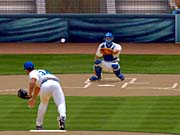
The overall selection of play modes and extras is just right to satisfy the needs of both casual players and fantasy enthusiasts. It takes only a minute or so to dive into an exhibition game, start a season, or participate in a playoff bracket. The home run derby mode is based upon the actual Big League Home Run Challenge that occurs every year at Cashman Field in Las Vegas. The event is basically an All-Star Game without fielders, where National League and American League hitters compete to see which team can smash the most home runs. Although you can't play against your friends online, the Sega Sports challenge lets you submit codes to the Sega Sports Web site in order to compare your skills with those of other players around the world.
All 30 MLB teams and their stadiums are available, and rosters are current as of January 2003. The included player editor lets you create an almost unlimited number of custom players. In addition to the 30 standard teams and venues, the game includes a legends team and five classic ballparks. A handful of throwback and alternate jerseys are available from the game setup menu.
Devoted baseball buffs will love the franchise mode, where you control a team throughout a span of multiple seasons. World Series Baseball 2K3 has the deepest franchise mode of any baseball game. You're in charge of every aspect of your team. This includes drafting players, setting lineups, and making trades, as well as managing the disabled list, performing minor league call-ups, and deciding when to give your players some rest. Tired players don't perform as well in the field, so it's necessary to provide a day off once in a while. You have the option to specify the percentage of time off given to each member of your team, which the CPU can use to automatically adjust your lineup whenever a fatigued player takes a day off.
The franchise mode also captures the spirit of baseball as a business. During the season, your team's success will influence the number of spectators that come to see your team play. This in turn gives you a bigger budget to spend on free agents and to retain veterans who are in the final year of their contracts. In the off-season, you have a 10-day period within which to negotiate with free agents throughout the league. You can make multiple offers per day, but you won't know if a player has accepted or rejected your offer until the following day. In this fashion, you can negotiate with players, but the limited time frame challenges you to sign players before the deadline arrives.
Player loyalty is another new feature of World Series Baseball 2K3. If you make it to the playoffs, give your players plenty of time off, and tend to pay well, you'll have a better shot at signing a star player to an extension or getting an aging veteran to sign a cheaper contract. If your team does poorly, however, or you work your players to death, a star player may opt to test the free-agent market instead.

In addition to paying the players you sign, you have to spend money on the managers, coaches, and scouts that support your team. It costs more to hire a top-notch support staff, but their skill ratings play a considerable role in the quality of prospects you develop, as well as in the strength and stamina of your everyday players. Throughout the season, you have the option of modifying the areas that your staff members focus on. For example, if your pitchers are tiring out by the fifth inning, you can have your pitching coach spend less time working on velocity and more time on building up the stamina of your pitching staff. If a member of your staff doesn't do his or her job, you have the option of firing that person and trying to hire a replacement.
Even though the franchise mode in World Series Baseball 2K3 is more comprehensive than the franchise modes offered by other baseball games, it does have a few omissions that are worth noting. The minor league system has only one level, as opposed to the multitiered farm club system you'll find in 3DO's High Heat Major League Baseball 2004. The ability to participate in spring training games is also absent, which is disappointing since every other game currently available has this feature. Everything else you could want is here though: fictional rookies, retirements, weekly and postseason awards, Hall of Fame inductions, minor league development, historical statistics, statistical tracking in more than 88 categories, and so on. The franchise mode is truly a micromanager's dream come true.
On the field, World Series Baseball 2K3 is fun to play and generally faithful to the nuances of the sport. Pitchers will shake off pitches they don't like, and you can have them take a look toward runners on base before leading into their windups. As is true in an actual game, balls hit low in the strike zone result in grounders more often than those hit high, and breaking pitches such as curveballs and sliders are more apt to result in weak hits than fastballs and change-ups. Baserunning is one of the game's strongest aspects. You can have your runners take a lead, break for a steal, or hold position on the line while the ball is in play. When you're up to bat, you can call for an immediate steal, or you can queue up the steal such that the runner will take off when the pitcher starts his delivery. This leaves you free to concentrate on taking a swing.
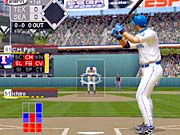
The default batting interface uses an oval-shaped cursor to portray the contact zone. As the pitch comes in, you have to move the cursor toward the general direction of the ball and decide whether or not to swing. Balls hit in the center of the cursor tend to land in the gaps more often than those hit along the diameter. You also have the option to swing for contact or for power depending on the button you press. If you want more control over the strength of your swing, you can enable an option that allows you to charge power into your swing during the pitcher's windup. Conversely, there's also a setting to take away the cursor altogether so that all you have to do is focus on the timing of your swing.
Pitching is relatively straightforward as well. An overall selection of nine pitches is shown on the screen in a three-by-three grid. To select a pitch, you press the control stick in the direction represented by the pitch's box on the grid and then tap the action button. Some pitches are blacked out, which means that your pitcher doesn't have that particular pitch in his repertoire. After you select the pitch, you use a cursor that's shaped like a ball to choose the location. Pressing the action button will cause the pitcher to step into his windup motion, but you still have time to change the location of the pitch up until the moment the ball is released. In this manner, it's possible to play against human opponents without telegraphing your pitches.
Visible hot and cold zones add an additional element of strategy to the pitching process. The strike zone is separated into nine rectangular areas. These areas represent the hot and cold tendencies of the hitter at the plate. Pitches thrown into the red areas are more likely to be lofted for base hits and home runs, while pitches aimed at the blue areas are more apt to bounce toward an infielder or fly out. This gives you some idea of where to locate a pitch if you're going to throw into the zone, but it's possible for a batter's tendencies to change if you continually toss pitches into the same spot.
Defense is similar to what you'll find in other baseball games. Once the ball flies off the bat, you have control over the fielder located nearest to the ball. If you're close to the ball, you'll automatically catch it. The setup menu lets you enable assisted fielding, which moves your player under the ball once you near the landing area, and automatic fielding, where the CPU controls the fielding for your team. Relay throws from the outfield incorporate the use of a cutoff man, which gives you a great deal of leeway if you change your mind about where you'd like a throw to go. All you have to do is press the button for a different base, and the second baseman or shortstop will intercept and redirect the throw. A good aspect of the defense is that fielders don't always make accurate throws. Your players may need to step off base or jump in order to catch the ball, which means that quick runners may leg out a base hit from time to time.
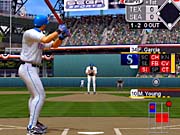
Vertical jump plays are another feature new to World Series Baseball 2K3, and they're designed with realism in mind. When you're going after a home run ball in the outfield, you have to push the button a few seconds before the ball reaches the wall in order to give the fielder time to wind up into a leap. Even though regular diving catches were a part of the game last year, the inclusion of vertical leaps provides you with the opportunity to rob line drives and home runs, as well as field a routine assortment of ground balls and infield liners.
When it comes to play mechanics, World Series Baseball 2K3 is just shy of perfect. The only areas that need improvement relate to the pitching interface: intentional walks and pitch selection. There isn't an option to signal an intentional walk, so you have to sit through four straight outside pitches before the batter takes his base. Other games allow you to select a distinct intentional walk command and only subject you to the final pitch. As for pitch selection, the game is missing a number of advanced pitches that many superstar pitchers have in their repertoires. The fosh, knuckle curve, forkball, and biting curve are just a few that come to mind. Unless you're intensely fussy, neither of these gripes should diminish your enjoyment of the game.
Although the game plays well, most people are likely to point out its rich, broadcast-style presentation as the factor that sets it apart from other baseball video games. Sega teamed with ESPN, the worldwide leader in sports, to give World Series Baseball 2K3 an authentic look. This means that you'll see familiar ESPN overlays and transitions while you play the game. The postgame recaps and menus are identical to the score summaries shown on SportsCenter, and the score display in the batting view is reminiscent of the graphics that overlay the screen during a live telecast on ESPN. The default audio settings also mimic the tone of a television broadcast. There are separate volume levels for the crowd, PA announcer, music, sound effects, umpires, and commentators, and they're initially set up such that the ballpark atmosphere is subdued compared with the commentary and music that originate in the broadcast booth. A particularly nice touch is that the musical selections are actually the same ditties you can hear while tuning in to the various sports wrap-ups on ESPN. This includes the themes to Baseball Tonight and SportsCenter.
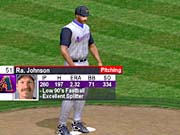
ESPN influences notwithstanding, the graphics and audio in World Series Baseball 2K3 are exceptional. The game's visuals are extremely sharp, which means that you can actually read the small print on signs in the outfield or notice patterns mowed into the grass on the field. The amount of detail is astonishing. Cars drive along the freeways outside Great American Ballpark in Cincinnati, and you can actually see the spectator boxes sitting atop the sports bars outside Wrigley Field in Chicago. Inside ballparks with an open-air design, birds often make impromptu flights onto the field. For the most part, the faces of the players and their uniforms are right on. The lighting in the ballpark is especially impressive. You've probably come to expect player shadows and overcast shade in baseball video games, but World Series Baseball 2K3 goes so far as to dynamically shade the wrinkles on players' uniforms.
Player movements are also more realistic this year. There are many new animations for actions such as snap throws, reaching grabs, and somersault double plays, all of which come together to deliver a more lively impression. Some actions are still a little too robotic, however. For instance, when players walk up to the plate, their batting stances loop so quickly that they appear to be stirring the air. In the field, base runners flail their arms like robots whenever they reach base, rather than displaying the smooth side-to-side motion you'd expect from. None of these oddities influences the game's overall look, but they're too eerie to ignore.
The primary thing Sega needs to do next year to improve the game's production values is to pep up the audio. Even though the volume level of the commentary is meant to drown out the noise of the crowd and the public-address music, the atmosphere within the stadium doesn't change much in response to rallies, close games, or blowouts. If you've ever watched a baseball game on television, you know how loud the stadium music and the spectators can get during a late-inning rally.
Aside from the lack of vigor, the audio in World Series Baseball 2K3 conveys everything necessary to create a realistic ballpark setting. Fans in the seats respond to balls, strikes, walks, and fly balls with varying degrees of excitement. If you're playing the home team, for example, and you pop up to the infield, the spectators will boo, knowing that the opposing team is going to catch the ball for an out. When the situation is reversed, however, and you're on the visiting team, they'll cheer instead. World Series Baseball 2K3 is also one of the few games that feature player-specific catcalls. Fans behind the plate express their fair share of positive and negative comments about the batter currently up to bat, and they have specific phrases reserved for individual players as well. It isn't uncommon, for example, for someone in the stands to make fun of Derek Jeter's proclivity for dating supermodels. In addition to the fans, you'll also hear the PA announcer introduce players during their at-bats, vendors hawking food in the stands, and musical snippets prior to the at bats of home-team players.
It's too bad that Sega didn't enlist any familiar ESPN personalities to provide the play-by-play and color commentary. Nonetheless, the in-game commentary does a nice job of keeping pace with the events displayed on the screen. Ted Robinson, a broadcaster who covers the Mets organization, has the play-calling duties. His voice is the auditory equivalent of sleeping pills, but the vocabulary he uses to describe the various teams and the plays that occur is satisfying due to its diversity. Rex Hudler provides the color commentary, giving anecdotes and historical background whenever an interesting player comes to the plate. Hudler is a former player himself and is currently a broadcaster for the Anaheim Angels. He has a gruff voice and speaks in a blue-collar style that's quite a contrast to Robinson's clean-cut mannerisms.
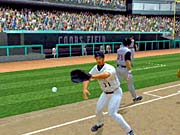
Since World Series Baseball 2K3 is also available for Microsoft's Xbox console, you're probably wondering how the PlayStation 2 version compares with its Xbox counterpart. In terms of play mechanics and overall selection of features, they're identical. The main difference is that the graphics are sharper on the Xbox. Certain transitions are also jumpier in the PS2 version. For example, whenever you hit a foul ball into the seats, the viewpoint switches away from the batter's view before the player follows through on his swing. In the Xbox game, you can see the follow-through.
Compared with the other baseball games currently available for the PlayStation 2, World Series Baseball 2K3 is at the top of the curve. It's easy to play and deep enough to lose yourself in. The ESPN branding may seem like a gimmick at first, but it's really just one part of a thoroughly enjoyable product.